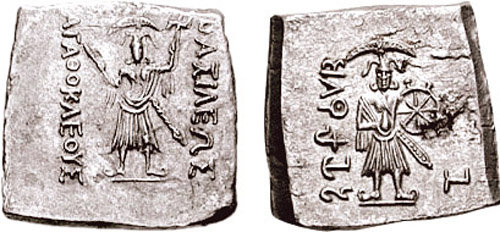
File:KINGS of BAKTRIA. Agathokles. Circa 185-170 BC. AR Drachm (3.22 gm, 12h). Bilingual series. BASILEWS AGAQOKLEOUS with Indian god Balarama-Samkarshana.jpg
| |
This is a file from the Wikimedia Commons. Information from its description page there is shown below.
Commons is a freely licensed media file repository. You can help. |
Summary
| DescriptionKINGS of BAKTRIA. Agathokles. Circa 185-170 BC. AR Drachm (3.22 gm, 12h). Bilingual series. BASILEWS AGAQOKLEOUS with Indian god Balarama-Samkarshana.jpg |
KINGS of BAKTRIA. Agathokles. Circa 185-170 BC. AR Drachm (3.22 gm, 12h). Bilingual series. BASILEWS AGAQOKLEOUS, the Indian god Balarama-Samkarshana standing facing, wearing ornate headdress, earrings, and sheathed sword, brandishing gada in his right hand, holding plow-symbol in left / “Rajane Agathuklayasa” in Karosthi, the Indian god Vasudeva-Krishna standing facing, wearing ornate headdress, earrings, and sheathed sword, holding sankha in his right hand, chakra (ornamented wheel) in left. Audouin & Bernard, “Trésor de monnaies indiennes et indogrecques d'Aï Khanoum (Afghanistan),” RN 1974, pl. I, 1-6; Bopearachchi Série 9A; SNG ANS -; MIG Type 149a; MACW -. EF, area of minor roughness on reverse. Extremely rare. ($7500) The discovery in 1970 at the excavations at Aï Khanoum of six Indian-standard drachms confirmed that bilingual coinage existed as early as the reign of Agathokles. While bilingual bronze issues were already known for him, these silver drachms, all unworn and closely die-linked (two obverse and three reverse dies), were completely unknown prior to the discovery of the hoard. Based on the presence of bronze coins in the hoard from the Taxila mint, Audouin and Bernard have suggested these drachms were also struck there, and thus locate Agathokles’ centre of control to Alexandria of the Caucasus in the Hindu Kush, capital of a territory that covered much of present-day Afghanistan, Pakistan, and the Punjab. Balarama-Samkarshana, holding the gada and plow-symbol, and Vasudeva-Krishna, holding the sankha (a pear-shaped vase or conch) and chakra, are the earliest incarnations of Vishnu and, like Lakshmi on the bronzes, are the earliest representations of Vedic divinities on non-Hindu coinage. The presence of these gods on the coinage also indicates the developing cultural relationship between the Hellenistic Greeks and their Indian neighbors. Megasthenes, author of the now lost Indica, had been appointed by Seleukos I Nikator as ambassador to Chandragupta, ruler of the Mauryan Empire. But it was Heliodoros, an ambassador from Antialkidas to Kasiputra Bhagabhadra in Besnagar, who most clearly exemplified this connection. On a column dedicated to Vasudeva he erected there in 113 BC he declared himself in the Brahmi inscription to be a devotee of Vishnu. |
| Date | 10 January 2005 |
| Source | www.cngcoins.com (57544) |
| Author | CNG |
Source:
www.cngcoins.com
Licensing
|
|
The permission to use this work has been archived in the Wikimedia OTRS system. It is available as ticket #2006092710009217 for users with an OTRS account. If you wish to reuse this work elsewhere, please read the instructions at COM:REUSE. If you are a Commons user and wish to confirm the permission, please leave a note at the OTRS noticeboard. Ticket link: https://ticket.wikimedia.org/otrs/index.pl?Action=AgentTicketZoom&TicketNumber=2006092710009217 |
File usage
Did you know...?
All five editions of Schools Wikipedia were compiled by SOS Children's Villages. In 133 nations around the world, SOS Children's Villages works to bring better education and healthcare to families in desperate need of support. Find out more about sponsoring a child.


